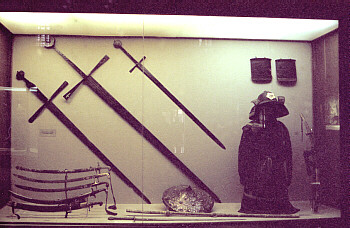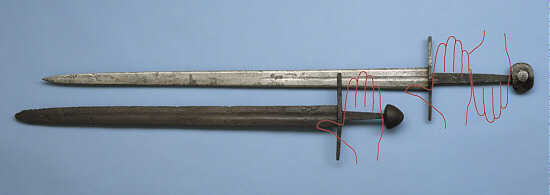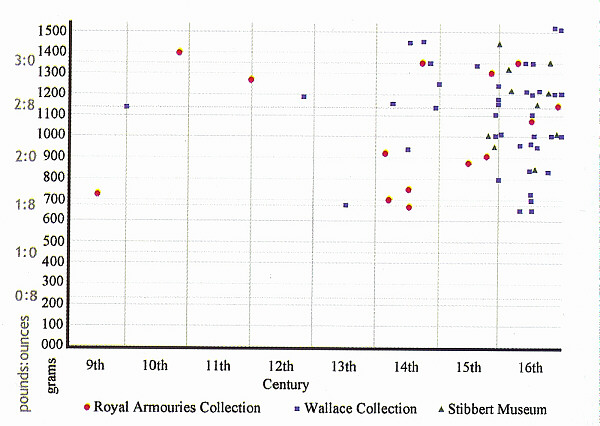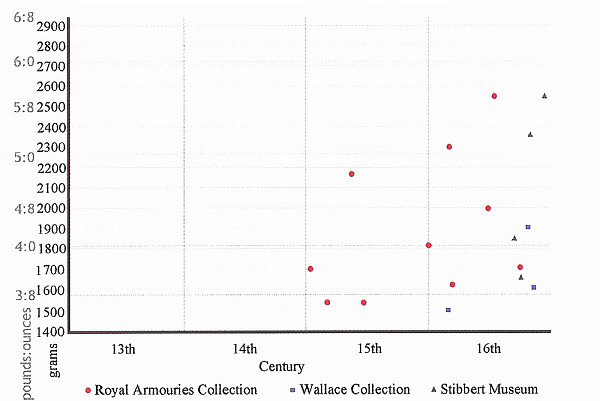'A club with an edge'
Journal of Western Martial Art
February 2005
by Dr. Timothy Dawson
The image of medieval and Renaissance weaponry in Europe, just as many other areas of life in the period, is the subject of many widely accepted 'facts' of uncertain origin. The remark that gives this article its title embodies two of the most widespread of these.
Originally published in "Medieval History Magazine", Volume 2, Number 3
 Enormous "bearing swords" on display in the Topkap Palace, Istanbul. The full-sized samuari armour on the right provides an indication of the scale. (Photograph © Timothy Dawson) |
The two ideas it expresses are that swords of the narrowly-defined 'Middle Ages' (that is prior to c.1400, to pick a somewhat arbitrary figure) were clumsy, heavy bludgeoning implements, and that, conversely, swords of the 'Renaissance' (after c.1400), and especially the late Renaissance, were light and dexterous tools. This dichotomy is by no means confined to proponents of Renaissance pretension over 'Dark Age barbarism', nor those steeped uncritically in popular culture imagery. No, even some partisans of the Middle Ages hold to this view, noted scholars have been heard to say such things, and even some medieval re-enactment groups espouse such notions as part of their performances. But how true is it?
There are many thousands of surviving swords in collections around the world, with the quantity increasing as the period progresses. Unfortunately it is not yet the prevailing custom for curators to weigh their weapons, let alone to publish that information. The following information was collected from published catalogues of two collections, the Wallace Collection in London, and the Stibbert Museum in Florence, and from the files of the Royal Armouries Museum in Leeds. The RAM also kindly arranged for the weighing of some pieces in its collection which had previously not been so recorded.
 Typical examples of single-handed and two-handed swords from the Royal Armouries collection. The outlines of hands give scale. (Photograph © Trustees of the Royal Armouries.) |
Main classes of swords
In terms of contextualising the weight of a sword, it can be assigned to one of three functional categories of weapons intended for combat use -
1: designed for use in one hand;
2: designed for use in one hand or in two (referred to as 'hand-and-a-half' or 'bastard');
3: designed for use in two hands.
|
 A characteristic hand-and-a-half sword from the Royal Armouries collection. The outlines of hands give scale. (Photograph © Trustees of the Royal Armouries.) |
Obviously when a sword was custom made, the size and strength of the owner will have some effect, but even so, the intended use is commonly reflected in the length of the hilt. A sword intended for single handed use will have a grip little longer than the width of a palm, ~10cm / 4in. The grips of two-handed swords range from two palms to more than four palms, ~20-45cm / 8-18in. The category of hand-and-a-half swords is a little less clear and tends to merge with that of two-handed swords. As its name suggests, the minimum grip of a hand-and-a-half sword will be a palm and a half, ~15cm/6in, with the remainder of the second hand enclosing the pommel. But many such swords, particularly made in Germany, had a grip long enough to fully accommodate both hands while still being of such a weight that they could be used in one hand.
Swords of different eras
Single-handed swords run throughout our period. Cut and thrust swords ranged from 75 cm / 29 in to around 120 cm / 46 in. Their supremacy was unchallenged up to the later twelfth century and was re-affirmed in the seventeenth century. And, of course, they continued to be made and used to modern times. The swords sampled in this category range from plain, cross-hilted Viking swords of the eighth to tenth centuries to swept-hilted rapiers and basket-hilted swords of the sixteenth century. 'Bastard' swords begin to be seen in use from the end of the twelfth century. They persist to the end of our period (1600), and were particularly popular in the fifteenth century, but overall never attained the eminence of the other two forms. Hand-and-a-had swords cluster at both the upper weight and up length range of single-handed swords. The development of somewhat longer swords which could deliver more force by the use of two hands is associated with more protective armour as the long-established mail became more widespread and was supplemented by padded under- and over-garments brought back from the East. The evolution ofarmour continued as from the thirteenth century mail was increasingly covered, then replaced, by rigid pieces of armour. This led to the creation of the two-handed sword in the early fourteenth century. Over the next two centuries the armour became more protective and the swords longer until they reached their greatest functional size of around 150cm/5ft in the sixteenth century..
The results
Summary
These results show that full size single-handed swords normally occur in the range of c.650g / 1lb 7oz to c.1400g / 3lb 1.5oz, with a few heavier examples, presumably made for men of greater strength. Weapons at the lower end of that range are extremely fine and light, and yet, as the present author's own experiments have shown, they are nevertheless remarkably effective. Swords at the top of the range are still light enough that an average man can use them with dexterity and precision. Hand-and-a-half swords had to be capable of being used effectively with one hand, so it is no surprise to find that they fall largely within the same range as single-handed swords, albeit clustered at the top end - ~800g / 1lb 12oz to ~1400g / 3lb 1.5oz. The greater strength and control that can be exercised with two hands can lead to a more than doubling in weight - ~1500g / 3lb 3oz to (in this sample) just ~2600g / 5lb 8oz.
Conclusion
From these examples it can be seen that the idea that medieval and Renaissance swords were heavy, clumsy objects is far from true. Single-handed swords could be very light, and even the heaviest two-hander was amenable to dexterous use. And the evidence is clear that even quite early in the period there were sophisticated techniques available to best employ such finely made tools ... but that is another story! So when next you hear anyone talking about the great weight of medieval swords, set them straight.
|
 About the author: Involved in the then-embryonic medieval re-enactment scene in Australia
since 1979, Timothy Dawson rapidly established himself as not only a skilled
fighter, but also a dedicated researcher and accomplished teacher of
historical European combat, laying the foundations for a style that came to
dominate Australian medieval re-enactment.
Timothy operated Australia's first historical European combat school, Amyna
(Greek for 'defence'), near Sydney from 1984 to 1987, and in 1985 published
a training manual embodying techniques practiced at that time. This manual
was rapidly superceded by further research, which has continued to the
present day, along with his teaching in Australia and now in Europe.
Through the 1980s and 1990s Timothy was also known as one of Australia's
finest makers of swords and other military equipment. This activity
embodied and informed his research and teaching in both arms and armour and
combat. Since then he has gone on to be internationally recognised
academically as an expert on certain forms of arms and armour.
For more information go to www.levantia.com.au.
About the author: Involved in the then-embryonic medieval re-enactment scene in Australia
since 1979, Timothy Dawson rapidly established himself as not only a skilled
fighter, but also a dedicated researcher and accomplished teacher of
historical European combat, laying the foundations for a style that came to
dominate Australian medieval re-enactment.
Timothy operated Australia's first historical European combat school, Amyna
(Greek for 'defence'), near Sydney from 1984 to 1987, and in 1985 published
a training manual embodying techniques practiced at that time. This manual
was rapidly superceded by further research, which has continued to the
present day, along with his teaching in Australia and now in Europe.
Through the 1980s and 1990s Timothy was also known as one of Australia's
finest makers of swords and other military equipment. This activity
embodied and informed his research and teaching in both arms and armour and
combat. Since then he has gone on to be internationally recognised
academically as an expert on certain forms of arms and armour.
For more information go to www.levantia.com.au.
Journal of Western Martial Art
February 2005


